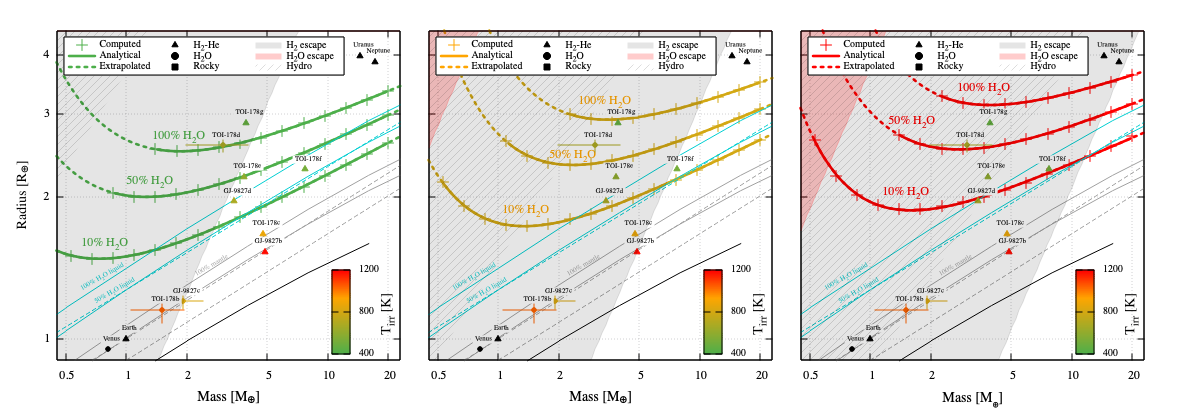- 1Aix Marseille Univ, Institut Origines, CNRS, CNES, LAM, Marseille, France (artem.aguichine@lam.fr)
- 2Aix Marseille Univ, Institut Origines, CNRS, CNES, LAM, Marseille, France
- 3LATMOS, Université Paris-Saclay, Guyancourt, France
Water-rich planets should be ubiquitous in the universe, and could represent a notable fraction of the sub-Neptune population. Among the detected exoplanets that have been characterized as sub-Neptunes, many are subject to important irradiation from their host star. As a consequence, hydrospheres of such planets are not in condensed phase, but are rather in supercritical state, with steam atmospheres on top. Such irradiated ocean planets (IOP) are good candidates to explain the distribution of masses and radii in the sub-Neptune category of exoplanets [1].
Here, we present the IOP model that computes the structure of water-rich planets that have high irradiation temperatures. The IOP model [2] combines two models in a self-consistent way: one for the interior structure, and one for the steam atmosphere. The interior structure model [3] contains several refractory layers (iron core and rocky mantle), and on top of them an hydrosphere with an up to date equation of state (EOS) with a validity range that extends to the plasma regime. The atmosphere model [4] connects the top of the interior model with the host star by solving equations of radiative transfer.
Our model has been applied to the GJ 9827 system as a test case and indicates Earth- and Venus-like interiors for planets b and c, respectively. Planet d could be an irradiated ocean planet with a water mass fraction of ∼20 ± 10%. We also compute mass-radius relationships for IOP and their analytical expression, which can be found in [2]. This allows one to directly retrieve a wide range of planetary compositions, without the requirement to run the model.
Due to their high irradiation temperatures, sub-Neptunes are expected to be subject to strong atmospheric escape. This supports the idea that a massive hydrosphere could be the remnant of a complete loss of an H-He envelope. The stability of hydrospheres themselves is discussed as well [5].

Figure 1. Mass-radius relationships produced by our model (green, yellow and red thick lines) [2], compared to mass-radius relationships of planets with only condensed phases and no atmosphere (black, grey and light blue thin lines). A few planets of the solar system, the GJ-9827 system and the TOI-178 system are represented as well. Shaded regions correspond to important atmospheric loss by Jeans escape (H and H2O), or hydrodynamic escape.
[1] Mousis, O., Deleuil, M., Aguichine, A., et al. 2020, ApJL, 896, L22.
[2] Aguichine, A., Mousis, O., Deleuil, M., et al. 2021, ApJ, 914, 84A.
[3] Brugger, B., Mousis, O., Deleuil, M., et al. 2017, ApJ, 850, 93.
[4] Marcq, E., Baggio, L., Lefèvre, F., et al. 2019, Icarus, 319, 491M.
[5] Vivien, H., Aguichine, A., Mousis, O., et al. 2022, accepted in ApJ.
How to cite: Aguichine, A., Mousis, O., Deleuil, M., Marcq, E., and Vivien, H.: Interior structure and possible existence of irradiated ocean planets, Europlanet Science Congress 2022, Granada, Spain, 18–23 Sep 2022, EPSC2022-904, https://doi.org/10.5194/epsc2022-904, 2022.

